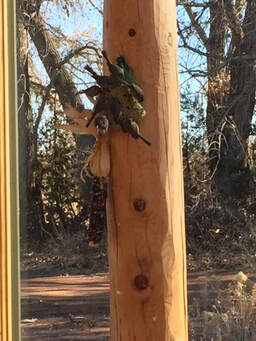 Late in December I noticed one morning that my suet was covered with tiny little light gray birds that I had never seen before. About thirty clustered together almost like the way bats do. High pitched chirps, peeps, and chattering filled the air. All plumages of these little birds are similar; They have gray caps, blue-gray upper-parts, and white or buff colored under - parts. I continued to be regaled by these little birds for about two months. They are now disappearing either because they are migrating elsewhere or in part because at least one hundred noisy evening grosbeaks have taken over the porch. The Pygmy Nuthatch (Sitta pygmaea) is a tiny roundish songbird less than four inches long. They range from British Columbia, south through various ‘discontinuous’ parts of the northwest, Sierra Nevada range, southern Rockies and down to Mexico. Pygmy nuthatches are amazing acrobats, clambering through the cottonwood branches; less often they creep along limbs or the trunk like bigger nuthatches. I can literally watch them for hours. They are supposed to live almost exclusively in long-needled pine forests and are particularly closely associated with ponderosa pines. Their normal forest habitat includes stands of older, large trees, pines, oak, aspen maple and fir so what were they doing here? Since they depend upon cavities in old trees (snags) for roosting and nesting, Pygmy Nuthatches are most abundant in forests that have escaped heavy logging and snag removal. They range up to 10,000 feet in the California mountains, and even higher in Mexico. Pygmy Nuthatches eat insects, other invertebrates and seeds. Here, besides the suet cakes they loved (a fact that this writer never found in print) they also feasted on both sunflower and mixed seeds. During the breeding season they eat mostly arthropods—including beetles, wasps, ants, bugs, caterpillars, and spiders—by probing cracks, scaling off loose bark, and gleaning from needle clusters and cones. Pygmy Nuthatches cache seeds year-round by hammering them into crevices or under flakes of bark on the tree, saving them for later. The male appears to take the lead in choosing a woodpecker hole or natural cavity as a nest site, usually in the trunk of a ponderosa pine or other long-needled pine, but sometimes in other species. Pygmy Nuthatches nest in live trees, dead trees, dead parts of live trees, and nest boxes. Pygmy Nuthatches can excavate their own cavities, but often they just enlarge and adapt existing ones, creating irregular holes about 5–10 inches deep and 1–6 inches across. Both the male and the female, sometimes assisted by their offspring from previous years, help dig out the nest cavity and bring lining materials. In the bottom of the hole they build a nest cup of bark shreds, fine moss, grass, plant down, fur, wool, snakeskin, cocoons, and often feathers. They may also stuff similar materials in crevices within the cavity, helping to weatherproof the nest. The pair keeps lining the nest during egg-laying during which time 5 -9 eggs are laid. The nestlings fledge in about a month. Pygmy Nuthatches are cooperative breeders: about one third of breeding pairs get help raising their young from 1–3 male relatives. These are often the breeding pair’s own sons from previous years; they help defend the nest and feed incubating females and chicks. To deter squirrels, Pygmy Nuthatches may sway threateningly from side to side or even cover the entrance with their bodies to make it less visible. In winter, multiple family groups join up to form large, chattering, highly social flocks that range over a foraging territory. These flocks also forage with other species including warblers, chickadees, bushtits, kinglets, woodpeckers, and juncos. This is exactly what happened here. In cold weather they seek out well-insulated cavities to spend the night. Pairs roost together and juveniles roost with their parents as part of larger groups. Sometimes more than 150 individuals sleep in a single tree, stacked up in squares, triangles, diamonds, oblongs, or tiers of birds. They use controlled hypothermia to withstand cold winter nights, a strategy which no other North American bird species uses in combination with group-roosting in cavities. At dusk every evening I could see what looked like hundreds gathered in the single closest cottonwood tree to the porch. They always arrived to feed at dawn. Because Pygmy Nuthatches have a tendency to move around in large groups it makes them difficult to count as I learned trying to figure out how many of these delightful little birds I had on my porch at one time. I put out two extra suet cakes to keep them happy! Throughout the twentieth century, logging, grazing, and fire suppression converted many ponderosa pine forests into mosaics of differently aged trees and dense thickets. The Pygmy Nuthatch population has declined as a result, since the nuthatches rely on mature pines and standing dead trees for suitable nest sites and foraging habitat. No doubt the catastrophic decline of insect species has also taken a toll on these little birds. Forest managers could help Pygmy Nuthatches and a host of other birds that nest in cavities by allowing some dead trees to remain standing. People can help increase Pygmy Nuthatch abundance by installing nest boxes in disturbed forest, which can double the number of breeding pairs in an area. Though they’re useful for nesting during the breeding season, boxes are rarely used for year-round roosting. Until this wild flock descended on me I had never even seen a Pygmy nuthatch before so I was particularly grateful to have them around for so long.
0 Comments
Your comment will be posted after it is approved.
Leave a Reply. |
Submit your ideas for local feature articles
Profiles Gardening Recipes Observations Birding Essays Hiking AuthorsYou! Archives
October 2025
Categories
All
|
 RSS Feed
RSS Feed